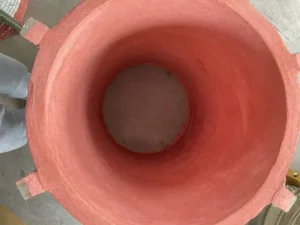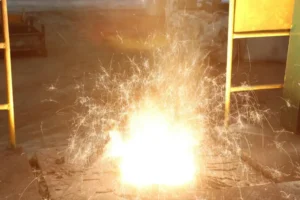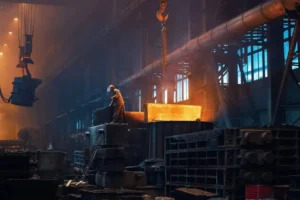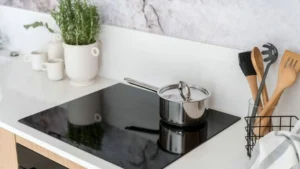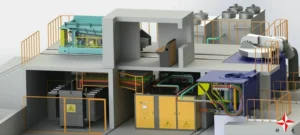การติดตั้งที่เหมาะสมและการว่าจ้างเตาหลอมเหนี่ยวนำเป็นสิ่งสำคัญสำหรับอายุการใช้งาน, ประสิทธิภาพการผลิต, และความปลอดภัย.
1. การเลือกไซต์สำหรับเตาเหนี่ยวนำความถี่ปานกลาง
การเลือกไซต์เป็นขั้นตอนแรกและเป็นขั้นตอนสำคัญสำหรับการติดตั้งเตาแบบเหนี่ยวนำ. ต้องพิจารณาปัจจัยหลายประการ:
- สภาพแหล่งจ่ายไฟ: ตรวจสอบให้แน่ใจว่า ความจุหม้อแปลง และ ระดับแรงดันไฟฟ้า จับคู่ความต้องการพลังงานของเตาความถี่กลาง, และอนุญาตให้มีการขยายตัวในอนาคต. หลีกเลี่ยงสถานที่ที่มีความผันผวนของพลังงานอย่างมีนัยสำคัญหรือเนื้อหาฮาร์มอนิกสูง; ถ้าหลีกเลี่ยงไม่ได้, พิจารณาการติดตั้งตัวกรอง.
- สภาพแหล่งน้ำ: ระบบระบายความร้อนของเตาเผาความถี่ขนาดกลางต้องการการจัดหาที่มั่นคง น้ำเย็น. เมื่อเลือกไซต์, พิจารณาความพร้อมใช้งาน, คุณภาพ (ความแข็ง, เนื้อหาเจือปน, ฯลฯ), ความดัน, และอุณหภูมิของน้ำ, และสำรองพื้นที่เพียงพอสำหรับอุปกรณ์บำบัดน้ำ.
- พื้นที่ไซต์: ตรวจสอบพื้นที่ที่เพียงพอสำหรับหน่วยเตาหลัก, ขดลวดเหนี่ยวนำ, ตู้ไฟฟ้า, ตู้เก็บของค่าชดเชย, ระบบทำความเย็น, คอนโซลควบคุม, และอุปกรณ์อื่น ๆ. อีกด้วย, ปล่อยให้พื้นที่เพียงพอสำหรับการตรวจสอบและการบำรุงรักษา. พิจารณาการไหลของวัสดุเข้าและออก, และการเคลื่อนไหวของผลิตภัณฑ์สำเร็จรูป.
- เงื่อนไขการระบายอากาศ: เตาเผาความถี่กลางสร้างความร้อนได้อย่างมากในระหว่างการทำงาน. การระบายอากาศที่ดีเป็นสิ่งจำเป็นสำหรับการกระจายความร้อนที่มีประสิทธิภาพและการป้องกันอุปกรณ์ความร้อนสูงเกินไป. เลือกไซต์ที่มีการระบายอากาศตามธรรมชาติหรือหนึ่งที่สามารถติดตั้งระบบระบายอากาศได้อย่างง่ายดาย.
- เงื่อนไขทางธรณีวิทยา: รากฐานจะต้องเป็นของแข็งและสามารถรองรับน้ำหนักของเตาเผาความถี่กลางและโหลดได้. สำหรับพื้นดินที่อ่อนนุ่ม, การเสริมแรงอาจจำเป็น.
- ด้านสิ่งแวดล้อม ปัจจัย: หลีกเลี่ยงความชื้น, เต็มไปด้วยฝุ่น, หรือสภาพแวดล้อมที่มีการกัดกร่อนสูง. อีกด้วย, พิจารณาผลกระทบของเสียงรบกวนในการดำเนินงานในพื้นที่โดยรอบ.
- ความปลอดภัย: The site should be away from areas storing flammable and explosive materials and must comply with local fire and safety regulations.
- Future Development: Reserve space for future equipment upgrades or expansion.
2. Foundation Construction
The quality of the medium frequency furnace’s foundation directly affects the stability and lifespan of the equipment.
- Foundation Load-Bearing Design: A professional engineer should design the foundation’s load-bearing capacity based on the total weight of the medium frequency furnace equipment (including the weight of the molten metal) and its dimensions. โดยทั่วไป, ก reinforced concrete foundation is required to withstand both static and dynamic loads during operation.
- Foundation Excavation and Pouring: Excavate the foundation strictly according to the design drawings, สร้างความมั่นใจในความลึกและขนาดที่แม่นยำ. ฐานของฐานรากควรมีการอัดแน่นและวางชั้นกันน้ำ. การเสริมแรงเหล็กจะต้องเชื่อมโยงตามข้อกำหนด, และคอนกรีตเทความหนาแน่นและหายอย่างเหมาะสมเพื่อให้ได้ความแข็งแรงที่ออกแบบมา.
- ชิ้นส่วนที่ฝังไว้ล่วงหน้า: ก่อนที่จะเทคอนกรีต, สลักเกลียวยึดไว้ล่วงหน้า, ร่องลึกสายเคเบิล, และช่องเปิดท่อน้ำตามภาพวาดการติดตั้งอุปกรณ์. ตรวจสอบให้แน่ใจว่าการวางตำแหน่งที่แม่นยำและการยึดที่ปลอดภัย. ชิ้นส่วนที่ฝังไว้ล่วงหน้าควรได้รับการรักษาด้วยการกัดกร่อน.
- การรักษาภาคพื้นดิน: หลังจากมูลนิธิเสร็จสมบูรณ์, พื้นที่ปฏิบัติการและพื้นโดยรอบควรแข็งตัว, ควรทนต่อการสึกหรอ, ไม่ลื่น, และวัสดุทำความสะอาดง่าย, สร้างความมั่นใจว่าพื้นผิวระดับ.
- คูน้ำ: Install drainage ditches around the medium frequency furnace to manage potential leaks from the cooling system or drainage during maintenance.

3. Induction Furnace Installation
Equipment installation is a critical step before commissioning and must strictly follow the manufacturer’s installation manual.
- Equipment Unpacking and Inspection: Upon arrival, immediately unpack and inspect the equipment. Verify the equipment model, quantity, and check for any damage or missing components against the packing list. Document any damaged parts with photos and contact the manufacturer promptly.
- Main Unit Placement: Hoist large equipment such as the medium frequency furnace main unit, ขดลวดเหนี่ยวนำ, ตู้ไฟฟ้า, and compensation capacitor cabinet into their designated positions. During hoisting, prioritize safety, use appropriate lifting gear, และหลีกเลี่ยงการชนหรือสร้างความเสียหายต่ออุปกรณ์. ครั้งหนึ่งในสถานที่, ใช้ระดับวิญญาณเพื่อให้แน่ใจ การจัดแนวแนวนอนและแนวตั้ง, จากนั้นยึดอย่างแน่นหนาด้วยสลักเกลียว.
- การติดตั้งขดลวดเหนี่ยวนำ: ติดตั้งคอยล์เหนี่ยวนำอย่างเคร่งครัดตามภาพวาด, ทำให้มั่นใจได้ว่าเหมาะกับตัวเตาเผา. ควรเชื่อมต่อท่อน้ำเย็นและสายตะกั่วของขดลวดเหนี่ยวนำอย่างถูกต้องและปิดผนึกได้อย่างน่าเชื่อถือ.
- สายเคเบิลระบายความร้อนด้วยน้ำและการเชื่อมต่อบาร์ทองแดง: เมื่อเชื่อมต่อสายเคเบิลระบายความร้อนด้วยน้ำและแถบทองแดง, ตรวจสอบให้แน่ใจว่าพื้นผิวที่สัมผัสนั้นสะอาดและแบน. นำมาใช้ การวางแบบนำไฟฟ้า และใช้เครื่องมือพิเศษเพื่อกระชับสลักเกลียว, สร้างความมั่นใจในการติดต่อที่ดีและความต้านทานน้อยที่สุด. รัศมีการดัดของสายเคเบิลระบายความร้อนด้วยน้ำควรปฏิบัติตามกฎระเบียบเพื่อหลีกเลี่ยงการบิดหรือดัดมากเกินไป.
- การติดตั้งระบบทำความเย็น:
- การติดตั้ง Cooling Tower หรือ Chiller: ติดตั้งหอระบายความร้อนหรือเครื่องทำความเย็นตามการออกแบบระบบทำความเย็น. ตรวจสอบการระบายอากาศที่ดีในสถานที่ติดตั้งและสำรองพื้นที่เพียงพอสำหรับการบำรุงรักษา.
- การติดตั้งปั๊มหมุนเวียน: ติดตั้งปั๊มน้ำหมุนเวียน, สร้างความมั่นใจในการเชื่อมต่อที่ถูกต้องของการดูดและท่อปล่อยของมัน, และเส้นผ่านศูนย์กลางท่อนั้นตรงตามข้อกำหนด.
- การเชื่อมต่อท่อ: เชื่อมต่อท่อระบายความร้อนและท่อทางออกสำหรับอุปกรณ์แต่ละชิ้น (แหล่งจ่ายไฟความถี่ปานกลาง, ตู้เก็บของ, ขดลวดเหนี่ยวนำ, ฯลฯ). การเชื่อมต่อท่อทั้งหมดจะต้องปิดผนึกอย่างปลอดภัยโดยไม่รั่วไหล. ติดตั้งเครื่องมือตรวจสอบเช่น Flow Meters, มาตรวัดแรงดัน, และเครื่องวัดอุณหภูมิ.
- การติดตั้งอุปกรณ์บำบัดน้ำ: ติดตั้งอุปกรณ์บำบัดน้ำเช่นน้ำยาปรับสภาพน้ำและตัวกรองเพื่อให้แน่ใจว่าคุณภาพน้ำเย็นเป็นไปตามข้อกำหนด, ป้องกันการปรับขนาดและการกัดกร่อน.
- การติดตั้งถังเก็บน้ำเย็น: ติดตั้งถังเก็บน้ำเย็น, สร้างความมั่นใจในความจุที่เพียงพอและเตรียมด้วยสัญญาณเตือนระดับน้ำและอุปกรณ์เติมเต็ม.
4. การเชื่อมต่อไฟฟ้า
การเชื่อมต่อไฟฟ้าเป็นแกนกลางของการติดตั้งเตาความถี่ปานกลางและจะต้องดำเนินการโดยช่างไฟฟ้ามืออาชีพที่ผ่านการรับรอง.
- การเชื่อมต่อวงจรหลัก:
- หม้อแปลงเป็นตู้ไฟฟ้า: เชื่อมต่อเทอร์มินัลเอาท์พุทด้านรองของหม้อแปลงไฟฟ้าเข้ากับขั้วขาเข้าของตู้ไฟฟ้าความถี่กลาง. พื้นที่ตัดขวางตัวนำจะต้องเป็นไปตามข้อกำหนดด้านกำลังการผลิตในปัจจุบัน, และการเชื่อมต่อควรแน่นและปลอดภัย.
- ตู้ไฟฟ้าไปยังตู้เก็บของ: เชื่อมต่อเทอร์มินัลเอาท์พุทของตู้พลังงานความถี่กลางเข้ากับขั้วขาเข้าของตู้เก็บค่าชดเชย.
- ตู้เก็บของไปยังขดลวดเหนี่ยวนำ: เชื่อมต่อเทอร์มินัลเอาท์พุทของตู้เก็บค่าชดเชยกับสายตะกั่วของขดลวดเหนี่ยวนำ.
- การต่อสายดิน: ปลอกอุปกรณ์ทั้งหมด, ตู้เก็บของ, คอนโซลควบคุม, และส่วนประกอบโลหะอื่น ๆ จะต้องน่าเชื่อถือ มีสายดิน. ความต้านทานต่อสายดินควรปฏิบัติตามมาตรฐานแห่งชาติเพื่อความปลอดภัยส่วนบุคคลและอุปกรณ์. พื้นที่ตัดขวางสายดินจะต้องเป็นไปตามข้อกำหนด.
- การเชื่อมต่อวงจรควบคุม:
- เชื่อมต่อโมดูลควบคุมทั้งหมด, เซ็นเซอร์, ตัวกระตุ้น, อุปกรณ์เตือนภัย, ปุ่มปฏิบัติการ, ไฟแสดงสถานะ, ฯลฯ, ตามแผนผังแผนผังไฟฟ้าของอุปกรณ์. สายเคเบิลควบคุมทั้งหมดควรมีหมายเลข, รวมกัน, และป้องกันน้ำและความชื้นได้อย่างเหมาะสม.
- ความปลอดภัย การเชื่อมต่อกัน: ตรวจสอบอุปกรณ์ความปลอดภัยทั้งหมด (เช่นขีด จำกัด ฝาของเตาหลอม, การป้องกันแรงดันน้ำเย็น, การป้องกันกระแสเกิน, การป้องกันแรงดันไฟฟ้าเกิน, ฯลฯ) เชื่อมต่ออย่างถูกต้องและทำการทดสอบการทำงาน.
- การวางสายเคเบิล: สายเคเบิลทั้งหมดควรวางในถาดสายเคเบิลหรือท่อร้อยสาย. ควรวางสายเคเบิลและสายสัญญาณสัญญาณแยกต่างหากเพื่อหลีกเลี่ยงสัญญาณรบกวนแม่เหล็กไฟฟ้า. รัศมีการดัดสายเคเบิลต้องสอดคล้องกับข้อกำหนด.
- ตรวจสอบแหล่งจ่ายไฟ: ก่อนที่จะเพิ่มพลังอุปกรณ์, ตรวจสอบการเชื่อมต่อไฟฟ้าทั้งหมดเพื่อความถูกต้อง, ความปลอดภัย, และไม่มีการลัดวงจรหรือวงจรเปิด. ใช้มัลติมิเตอร์หรือเครื่องมืออื่น ๆ เพื่อทดสอบความต้านทานและความต้านทานฉนวนในวงจร.
5. การว่าจ้างระบบน้ำ
การว่าจ้างระบบน้ำเป็นการรับประกันที่สำคัญสำหรับการทำงานที่ปลอดภัยของเตาเผาความถี่ขนาดกลางและต้องมีความละเอียดและครอบคลุม.
- การล้างท่อ: ก่อนการทำงานอย่างเป็นทางการ, ล้างระบบท่อส่งน้ำเย็นทั้งหมดเพื่อกำจัดสิ่งสกปรก, การต่อสู้เชื่อม, ฯลฯ, เพื่อป้องกันการอุดตัน.
- ไส้น้ำและ อากาศ เลือดออก: เติมน้ำเย็นด้วยน้ำ, ค่อยๆเปิดช่องระบายความร้อนและวาล์วทางออกของอุปกรณ์แต่ละชิ้น (แหล่งจ่ายไฟ, ตัวเก็บประจุ, ขดลวดเหนี่ยวนำ, ฯลฯ), และมีเลือดออกทั้งหมดจากท่อ.
- การทดสอบปั๊มหมุนเวียน: เริ่มปั๊มน้ำไหลเวียนและตรวจสอบการทำงานที่ราบรื่นและเสียงผิดปกติใด ๆ. ตรวจสอบว่าอัตราการไหลของน้ำเย็นและความดันตรงตามข้อกำหนดการออกแบบ.
- การตรวจสอบการรั่วไหล: ตรวจสอบการเชื่อมต่อท่อน้ำทั้งหมดอย่างระมัดระวัง, วาล์ว, และอุปกรณ์เชื่อมต่อสำหรับการรั่วไหล. หากพบการรั่วไหล, ปิดตัวลงทันทีและอยู่.
- การทดสอบและบำบัดคุณภาพน้ำ: ทดสอบคุณภาพน้ำเย็นเป็นประจำ, รวมถึงความแข็ง, ค่า pH, ค่าการนำไฟฟ้า, และของแข็งระงับ. ขึ้นอยู่กับผลการทดสอบ, เปิดใช้งานอุปกรณ์บำบัดน้ำ (น้ำนุ่มน้ำ, ตัวกรอง, ฯลฯ) เพื่อบำบัดน้ำ, ตรวจสอบให้แน่ใจว่าเป็นไปตามข้อกำหนดสำหรับการใช้เตาเผาความถี่ปานกลาง. ถ้าจำเป็น, เพิ่มสารต่อต้านการปรับขนาดและสารยับยั้งการกัดกร่อน.
- การทดสอบประสิทธิภาพการระบายความร้อน: หลังจากอุปกรณ์มีพลังและทำงาน, ตรวจสอบอุณหภูมิทางเข้าและทางออกของน้ำเย็นอย่างต่อเนื่องสำหรับแต่ละองค์ประกอบ, ทำให้มั่นใจว่าอุณหภูมิสูงขึ้นอยู่ในช่วงที่อนุญาต. ปรับอัตราการไหลของน้ำเย็นเพื่อให้ได้ประสิทธิภาพการระบายความร้อนที่ดีที่สุด.
- ความปลอดภัย การทดสอบการป้องกัน: จำลองสภาพความผิดพลาดเช่นแรงดันน้ำเย็นต่ำหรือการไหลไม่เพียงพอเพื่อทดสอบว่าอุปกรณ์ป้องกันน้ำหล่อเย็นเปิดใช้งานทันที, ตัดกำลังออก, และกระตุ้นการเตือนภัย.
6. ข้อควรระวัง
- ความปลอดภัย อันดับแรก: ตลอดกระบวนการติดตั้งและการว่าจ้าง, ความปลอดภัยต้องเป็นสิ่งสำคัญยิ่ง. ผู้ประกอบการจะต้องสวมใส่อุปกรณ์ป้องกันส่วนบุคคลและปฏิบัติตามขั้นตอนการปฏิบัติงานด้านความปลอดภัยอย่างเคร่งครัด. High-altitude work and electrical work must be supervised by professional personnel.
- Strict Adherence to Manufacturer’s Manual: Different brands and models of medium frequency furnaces may have specific installation details. Always strictly follow the installation and commissioning manual provided by the equipment manufacturer.
- Professional Personnel Operation: Medium frequency furnace installation and commissioning involve high voltage, high current, high temperature, and high-pressure water. It must be performed by experienced professional engineers and technicians.
- Record Keeping and Archiving: Detailed records of all data, test results, problems encountered, and solutions during the installation and commissioning process should be kept. Establish equipment archives for future maintenance reference.
- ระบบ การต่อสายดิน: Ensure all electrical equipment and metal structures are reliably มีสายดิน to prevent electric shock accidents and electromagnetic interference.
- Cooling Water Quality: Cooling water is the “lifeline” of a medium frequency furnace. It is essential to ensure water quality meets requirements and to regularly monitor and treat it to prevent scaling, การกัดกร่อน, and blockages that could damage the equipment.
- Power Supply Stability: Ensure a stable power supply and avoid excessive voltage fluctuations, which could affect normal equipment operation or cause damage.
- Spare Parts Preparation: Before installation and commissioning, prepare some wearing parts and common spare parts for timely replacement to minimize downtime.
- Personnel Training: After equipment installation and commissioning are complete, จัดให้มีการฝึกอบรมทางเทคนิคที่ครอบคลุมเพื่อการดำเนินงานและการบำรุงรักษา. พวกเขาควรคุ้นเคยกับหลักการทำงานของอุปกรณ์, ขั้นตอนการดำเนินงาน, การบำรุงรักษารายวัน, และวิธีการแก้ไขปัญหา.
โดยทำตามขั้นตอนและข้อควรระวังเหล่านี้อย่างเคร่งครัด, คุณสามารถมั่นใจได้ถึงคุณภาพของ เตาเหนี่ยวนำ การติดตั้งและการว่าจ้าง, วางรากฐานที่มั่นคงในระยะยาว, มีประสิทธิภาพ, และการทำงานที่ปลอดภัยของอุปกรณ์.


